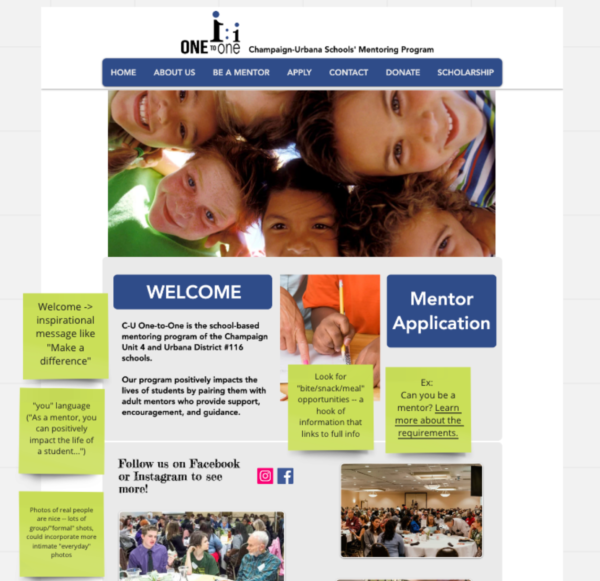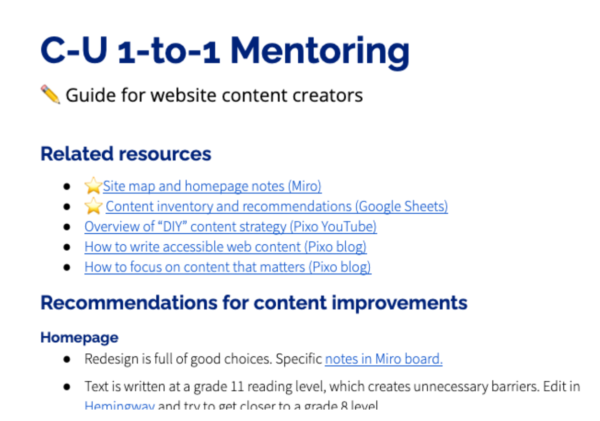Little time, less budget? Start with a content review
Introduction
One of Pixo’s core values is We Invest — not just in our people and our practice, but in our community too. Recently, an opportunity came up for us to do some pro bono work for C-U One-to-One Mentoring, the school-based mentoring program in our home city of Champaign-Urbana, Ill. Their program makes huge differences in students’ lives, and (like many other community groups doing similar good) they have limited time and budget to spend on their website.
You don’t need a huge budget to improve your website
When we met with C-U One-to-One, we heard some common problems. Their current site is built in Wix, but the person who’d set it up left long ago, and it was hard for the current administrator to keep up with the content. They didn’t have the resources to update the design. In our initial meeting, they said they didn’t even believe their website to be a valuable recruiting resource, which we took as a personal challenge to make this tool more useful.
With limited resources, we needed to approach this project wisely to give C-U One-to-One the most value. There wasn’t time for a lot of discovery work (e.g. interviews or usability testing), and no budget for a full site redesign.
So we started by looking at the heart of any site: the content.
How to review your web content
Content updates are often the most affordable changes you can make to a website — and it all starts with a content review. After our initial conversations with CU One-to-One, I leaned on my knowledge of best practices for content and what I’d learned about the organization’s site audiences.
I reviewed each page for:
- Readability (Is this content easy to read? Is it equitable?)
- Calls to action (Are next steps clear? Will the reader feel guided?)
- Relevance to the audience (Does the reader care about this?)
- Redundancy (Is this page necessary, or should it be combined with similar pages?)
The site should, above all else, inform your primary audience and help them achieve their goals — in this case, tell prospective mentors about the program and lead them to apply. I used this as the guiding principle for each page and tried to evaluate whether the text and images supported or detracted from that goal.

Turn your content review into action
Turn your content review into action
I made a list of all the pages on their website and added notes about each page’s content and my suggestions for making it more useful.
Based on the results of my content review, I then:
- annotated a screenshot of their current homepage with suggestions for more evocative and engaging text and imagery
- spun up a content guide for site administrators that included the suggestions for each page, plus standard best practices for writing useful, accessible web content
- made a site map to suggest combining similar content and getting rid of redundant pages (As a result of this effort, an unnecessary About page was vanquished from the web, and a content strategist somewhere got their wings.)

Conclusion
We met with C-U One-to-One Mentoring to walk through the site and our recommendations together. They were enthusiastic about the results of our review, made many of the changes, and even graciously sent us a thank-you card a couple weeks later.
Said Lauren Smith, the program’s community outreach coordinator:
“Our old website was so depressing, I didn’t even want to look at it… you pushed me to learn more about Wix and Hemingway edits! I used it for several pages and cut out even more text.”
We’re hoping that the website will serve as more of a recruitment tool for the group in the future. Either way, with fewer pages to update, clearer calls to action for new mentors, and text that’s easier for everyone to understand — we call that a win.
And if you have an hour a week to give to a student, consider becoming a mentor.
Call to action
Want more content help?
Check out these articles from the Pixo content strategy team: